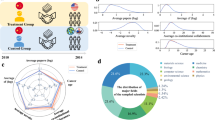Abstract
This work explores the distribution of citations for the publications of top scientists. A first objective is to find out whether the 80–20 Pareto rule applies, that is if 80 % of the citations to a top scientist’s work concern 20 % of their publications. Observing that the rule does not apply, we also measure the dispersion of the citation distribution by means of the Gini coefficient. Further, we investigate the question of what share of a top scientist’ publications go uncited. Finally, we study the relation between the dispersion of the citation distribution and the share of uncited publications. As well as the overall level, the analyses are carried out at the field and discipline level, to assess differences across them.





Similar content being viewed by others
Notes
The complete list is accessible at http://attiministeriali.miur.it/UserFiles/115.htm. Last accessed on 6 September 2016.
The harmonic mean of precision and recall (F-measure) of authorships disambiguated by the algorithm is around 97 % (2 % margin of error, 98 % confidence interval).
Professors with <3 years on duty were excluded from the analysis.
Abramo et al. (2012) demonstrated that this is the best-performing scaling factor.
For ease of presentation, in the following we use “citations” in place of “field-normalized citations”.
References
Abramo, G., Cicero, T., & D’Angelo, C. A. (2011). The dangers of performance-based research funding in non-competitive higher education systems. Scientometrics, 87(3), 641–654.
Abramo, G., Cicero, T., & D’Angelo, C. A. (2012). Revisiting the scaling of citations for research assessment. Journal of Informetrics, 6(4), 470–479.
Abramo, G., & D’Angelo, C. A. (2011). National-scale research performance assessment at the individual level. Scientometrics, 86(2), 347–364.
Abramo, G., D’Angelo, C. A., & Di Costa, F. (2010). Testing the trade-off between productivity and quality in research activities. Journal of the American Society for Information Science and Technology, 61(1), 132–140.
Bosquet, C., & Combes, P. P. (2013). Are academics who publish more also more cited? Individual determinants of publication and citation records. Scientometrics, 97(3), 831–857.
D’Angelo, C. A., Giuffrida, C., & Abramo, G. (2011). A heuristic approach to author name disambiguation in bibliometrics databases for large-scale research assessments. Journal of the American Society for Information Science and Technology, 62(2), 257–269.
Flegl M., & Vydrova H. V. (2014). Is Pareto’s 50-20 rule applicable in research? A case of Culs Prague. In 11th conference on “efficiency and responsibility in education”, Prague, June 2014.
Glanzel, W., & Moed, H. F. (2002). Journal impact measures in bibliometric research. Scientometrics, 53(2), 171–193.
Gupta, H. M., Campanha, J. R., & Pesce, R. A. G. (2005). Power-law distributions for the citation index of scientific publications and scientists. Brazilian Journal of Physics, 35(4A), 981–986.
Moed, H. F., & Van Leeuwen, Th N. (1996). Impact factors can mislead. Nature, 381, 186.
Parker, J. N., Allesina, S., & Lortie, C. J. (2013). Characterizing a scientific elite (B): publication and citation patterns of the most highly cited scientists in environmental science and ecology. Scientometrics, 94(2), 469–480.
Perianes-Rodriguez, A., & Ruiz-Castillo, J. (2015). University citation distributions. Journal of the American Society for Information Science and Technology. doi:10.1002/asi.23619.
Piro, F. N., Rørstad, K., & Aksnes, D. W. (2016). How does prolific professors influence on the citation impact of their university departments? Scientometrics, 107(3), 941–961.
Ruiz-Castillo, J., & Costas, R. (2014). The skewness of scientific productivity. Journal of Informetrics, 8(4), 917–934.
Seglen, P. O. (1997). Why the impact factor of journals should not be used for evaluating research. British Medical Journal, 314(7079), 497–502.
Weingart, P. (2004). Impact of bibliometrics upon the science system: inadvertent consequences? In H. F. Moed, W. Glänzel, & U. Schmoch (Eds.), Handbook on quantitative science and technology research. Dordrecht (The Netherlands): Kluwer.
Author information
Authors and Affiliations
Corresponding author
Rights and permissions
About this article
Cite this article
Abramo, G., D’Angelo, C.A. & Soldatenkova, A. The dispersion of the citation distribution of top scientists’ publications. Scientometrics 109, 1711–1724 (2016). https://doi.org/10.1007/s11192-016-2143-7
Received:
Published:
Issue Date:
DOI: https://doi.org/10.1007/s11192-016-2143-7




